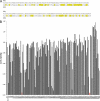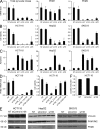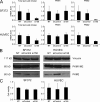Pyruvate kinase M2-specific siRNA induces apoptosis and tumor regression
- PMID: 22271574
- PMCID: PMC3280873
- DOI: 10.1084/jem.20111487
Pyruvate kinase M2-specific siRNA induces apoptosis and tumor regression
Abstract
The development of cancer-specific therapeutics has been limited because most healthy cells and cancer cells depend on common pathways. Pyruvate kinase (PK) exists in M1 (PKM1) and M2 (PKM2) isoforms. PKM2, whose expression in cancer cells results in aerobic glycolysis and is suggested to bestow a selective growth advantage, is a promising target. Because many oncogenes impart a common alteration in cell metabolism, inhibition of the M2 isoform might be of broad applicability. We show that several small interfering (si) RNAs designed to target mismatches between the M2 and M1 isoforms confer specific knockdown of the former, resulting in decreased viability and increased apoptosis in multiple cancer cell lines but less so in normal fibroblasts or endothelial cells. In vivo delivery of siPKM2 additionally causes substantial tumor regression of established xenografts. Our results suggest that the inherent nucleotide-level specificity of siRNA can be harnessed to develop therapeutics that target isoform-specific exons in genes exhibiting differential splicing patterns in various cell types.
Figures





Similar articles
-
Knockdown of the M2 Isoform of Pyruvate Kinase (PKM2) with shRNA Enhances the Effect of Docetaxel in Human NSCLC Cell Lines In Vitro.Yonsei Med J. 2016 Nov;57(6):1312-23. doi: 10.3349/ymj.2016.57.6.1312. Yonsei Med J. 2016. PMID: 27593857 Free PMC article.
-
Pyruvate kinase M knockdown-induced signaling via AMP-activated protein kinase promotes mitochondrial biogenesis, autophagy, and cancer cell survival.J Biol Chem. 2017 Sep 15;292(37):15561-15576. doi: 10.1074/jbc.M117.791343. Epub 2017 Aug 4. J Biol Chem. 2017. PMID: 28778925 Free PMC article.
-
PKM2 Knockdown Induces Autophagic Cell Death via AKT/mTOR Pathway in Human Prostate Cancer Cells.Cell Physiol Biochem. 2019;52(6):1535-1552. doi: 10.33594/000000107. Cell Physiol Biochem. 2019. PMID: 31135122
-
Turning on a fuel switch of cancer: hnRNP proteins regulate alternative splicing of pyruvate kinase mRNA.Cancer Res. 2010 Nov 15;70(22):8977-80. doi: 10.1158/0008-5472.CAN-10-2513. Epub 2010 Oct 26. Cancer Res. 2010. PMID: 20978194 Free PMC article. Review.
-
Pyruvate kinase: Function, regulation and role in cancer.Semin Cell Dev Biol. 2015 Jul;43:43-51. doi: 10.1016/j.semcdb.2015.08.004. Epub 2015 Aug 13. Semin Cell Dev Biol. 2015. PMID: 26277545 Free PMC article. Review.
Cited by
-
Pyruvate Kinase M2: A Potential Target for Regulating Inflammation.Front Immunol. 2016 Apr 21;7:145. doi: 10.3389/fimmu.2016.00145. eCollection 2016. Front Immunol. 2016. PMID: 27148264 Free PMC article. Review.
-
[Gefitinib inhibits glycolysis and induces programmed cell death in non-small cell lung cancer cells].Nan Fang Yi Ke Da Xue Xue Bao. 2020 Jun 30;40(6):884-892. doi: 10.12122/j.issn.1673-4254.2020.06.17. Nan Fang Yi Ke Da Xue Xue Bao. 2020. PMID: 32895203 Free PMC article. Chinese.
-
Tumor glycolysis as a target for cancer therapy: progress and prospects.Mol Cancer. 2013 Dec 3;12:152. doi: 10.1186/1476-4598-12-152. Mol Cancer. 2013. PMID: 24298908 Free PMC article. Review.
-
The eEF2 kinase-induced STAT3 inactivation inhibits lung cancer cell proliferation by phosphorylation of PKM2.Cell Commun Signal. 2020 Feb 13;18(1):25. doi: 10.1186/s12964-020-0528-y. Cell Commun Signal. 2020. PMID: 32054489 Free PMC article.
-
Epidermal growth-factor-induced transcript isoform variation drives mammary cell migration.PLoS One. 2013 Dec 6;8(12):e80566. doi: 10.1371/journal.pone.0080566. eCollection 2013. PLoS One. 2013. PMID: 24324612 Free PMC article.
References
-
- Ashizawa K., Willingham M.C., Liang C.M., Cheng S.Y. 1991. In vivo regulation of monomer-tetramer conversion of pyruvate kinase subtype M2 by glucose is mediated via fructose 1,6-bisphosphate. J. Biol. Chem. 266:16842–16846 - PubMed
-
- Bonnet S., Archer S.L., Allalunis-Turner J., Haromy A., Beaulieu C., Thompson R., Lee C.T., Lopaschuk G.D., Puttagunta L., Bonnet S., et al. 2007. A mitochondria-K+ channel axis is suppressed in cancer and its normalization promotes apoptosis and inhibits cancer growth. Cancer Cell. 11:37–51 10.1016/j.ccr.2006.10.020 - DOI - PubMed
-
- Boxer M.B., Jiang J.K., Vander Heiden M.G., Shen M., Skoumbourdis A.P., Southall N., Veith H., Leister W., Austin C.P., Park H.W., et al. 2010. Evaluation of substituted N,N’-diarylsulfonamides as activators of the tumor cell specific M2 isoform of pyruvate kinase. J. Med. Chem. 53:1048–1055 10.1021/jm901577g - DOI - PMC - PubMed
Publication types
MeSH terms
Substances
Grants and funding
LinkOut - more resources
Full Text Sources
Other Literature Sources
Medical
Miscellaneous

